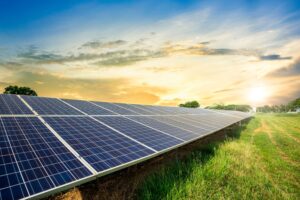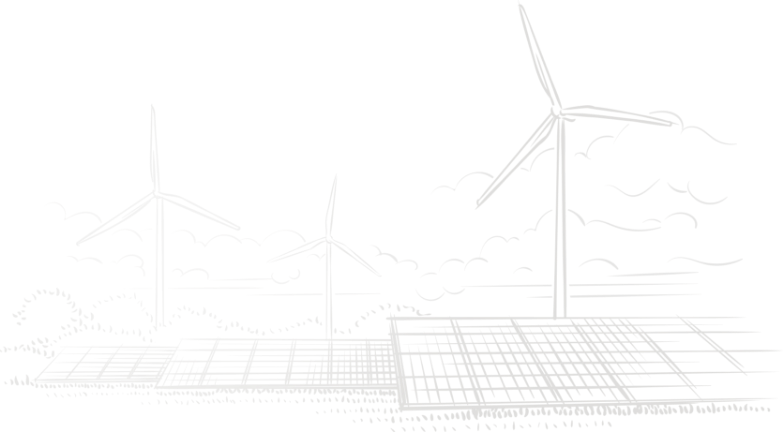Photovoltaic power generation is the process of converting solar radiation into electrical energy using the photovoltaic effect. The photovoltaic effect refers to the excitation of free electrons in a semiconductor material (usually silicon) when light shines on its surface, causing electrons to move inside the material and generate current.
Photovoltaic power generation systems typically consist of multiple photovoltaic cells. Each photovoltaic cell is composed of two layers of semiconductor materials: P-type semiconductor and N-type semiconductor. When sunlight shines on the surface of a photovoltaic cell, photons excite electrons near the P-N junction, causing them to transition into the conduction band and generate current. During this process, the electric fields on both sides of the P-N junction push electrons towards the wires of the battery, forming a current.
The generated DC current usually needs to be converted into AC power through an inverter for use in the power grid or household electrical equipment. In this way, solar energy is converted into usable electricity, achieving photovoltaic power generation.
The differences between solar energy, photovoltaic (PV) electricity generation, and solar heating lie in their working principles and applications:
1、Solar Energy: Solar energy refers to the process of directly harnessing solar radiation to provide energy. Solar energy applications include solar water heaters, solar thermal utilization, etc. Solar energy systems convert solar energy into thermal energy through collectors, which is then used for heating water, space heating, or other purposes.
2、Photovoltaic (PV) Electricity Generation: Photovoltaic electricity generation involves directly converting solar radiation into electricity using the photovoltaic effect. PV systems typically consist of photovoltaic cells, which generate electricity when sunlight strikes them, exciting electrons and creating a flow of current. This direct current (DC) electricity is often converted into alternating current (AC) using inverters for use in electrical grids or home appliances.
3、Solar Heating: Solar heating utilizes solar energy directly or indirectly to provide heat for buildings or water. Solar heating systems usually include collectors, thermal storage devices, and distribution systems. Collectors convert solar energy into thermal energy, which is then stored in thermal storage devices for heating purposes.
In summary, solar energy is a broad concept encompassing various applications, including solar heating and photovoltaic electricity generation. Photovoltaic electricity generation and solar heating are specific technologies and applications for utilizing solar energy, used in the generation of electricity and providing heat, respectively.
Photovoltaic modules and solar thermal collectors are two distinct solar energy utilization technologies with notable differences in their working principles, applications, and functionalities:
Photovoltaic Modules:
1、Working Principle: Photovoltaic modules utilize the photovoltaic effect to directly convert solar radiation into electricity. They consist of multiple photovoltaic cells, which generate electric current when sunlight strikes them, exciting electrons and creating a flow of electricity.
2、Applications: Photovoltaic modules are primarily used for solar electricity generation, converting solar energy into electrical power for grid-connected or off-grid applications in residential, commercial, and industrial settings.
3、Functionality: Photovoltaic modules are capable of generating electricity under various lighting conditions and have a wide range of applications. They can be used as standalone power systems or integrated into grid-connected photovoltaic arrays.
Solar Thermal Collectors:
1、Working Principle: Solar thermal collectors harness solar energy to convert solar radiation into heat energy. They absorb solar energy through collector panels, converting it into heat, which is then used for heating water or air.
2、Applications: Solar thermal collectors are primarily used for solar heating or solar hot water systems, where solar energy is converted into heat energy for space heating or hot water supply in residential, commercial, or industrial buildings.
3、Functionality: Solar thermal collectors are suitable for applications requiring large amounts of heat energy, such as space heating and hot water supply. They offer efficient heat conversion performance, reducing energy consumption and saving on energy costs.
In summary, photovoltaic modules and solar thermal collectors are two distinct solar energy utilization technologies used in solar electricity generation and solar heating applications, respectively. They differ in their working principles, applications, and functionalities, catering to different energy needs and requirements.
The inverter serves as both the “heart” and the “brain” of a photovoltaic (PV) system, playing a crucial role in its operation and management. As the “heart,” the inverter is responsible for converting the direct current (DC) electricity generated by the PV panels into usable alternating current (AC) electricity. This conversion process is essential for supplying power to the electrical grid or to household appliances, making the inverter a vital component for the system’s functionality. Additionally, as the “brain,” the inverter is equipped with monitoring, control, and safety features. It continuously monitors parameters such as sunlight intensity and temperature, adjusting voltage and frequency to optimize energy conversion efficiency. Moreover, it safeguards the system by preventing electrical issues such as overloading, overvoltage, and short circuits, ensuring the system operates safely and reliably. The inverter is not only the core component of a PV system but also its central control unit, providing essential support for the conversion of solar energy into usable electricity.







